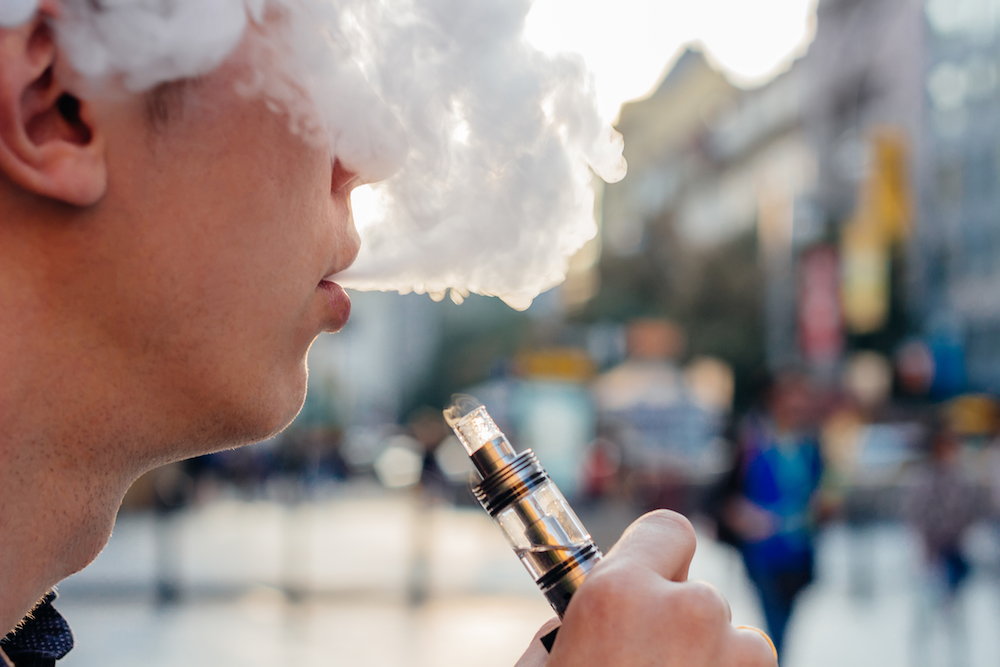By Charalampos Karouzos,
Smoking having its roots in prehistoric communities in what is now modern-day Mexico and Central America, as early as 2000 BCE, was used by numerous indigenous cultures in various religious, social, and medicinal rituals. However, its popularity worldwide must be attributed to Columbus and his crew, who along with their return to Europe after they explored the new world, introduced tobacco smoking to the continent. It took many centuries for smoking to be linked with diseases and finally be regulated and managed as a public health issue of great importance in the late 20th century, with the effects of the regulations having a positive impact on newer generations. The heavy restrictions and strong recommendations for cessation of the “old habit”, led to a need to create aids pharmaceutical and nature to combat the addiction; one of which was Vaping and E-cigarettes, a device advertised to assist in ceasing smoking, that today gained a different role.
Since entering the US market in 2007, e-cigarettes or vaping, designed as a unique approach to quitting smoking by providing the desired nicotine with much less harmful chemicals, products have evolved into a diverse class of inhaled aerosol devices. Earlier versions were disposable, resembling cigarettes in shape, and were designed to provide nicotine to the user. Newer generations are rechargeable, don’t resemble normal cigarettes, and apart from solely nicotine they are used to deliver substances like Tetrahydrocannabinol, also known as THC, the psychoactive compound of Marijuana. Their popularity has drastically grown in developed countries, especially among the demographic of young individuals, middle school, and high school students.
Vaping as an alternative and a substitute for normal tobacco smoke is of great benefit to the user as it’s a useful tool in assisting unhooking from the nicotine addiction, however, vaping should not be examined solely as a safer alternative compared to smoking and its dangers must not remain hidden. Current vaping users, young adults, are exposed to a product with attractive flavors, like peanut butter cookies, in an easily concealable device that does not resemble the traditional “harmful” cigarette shape, but at the same time delivers very high doses of dopamine desired. Products like the innovative Juul, utilize nicotine salts, which allow high dosages of nicotine to be inhaled more easily compared to older e-cigarettes. Nicotine apart from being a potent neurostimulator in the nervous system, is also used as a pharmaceutical drug in the treatment of various neurological and psychiatric disorders, if misused it can be highly addictive and harm brain development which endures through the mid-20s. In addition, concern has been raised further, especially in areas of the world where marijuana products are legalized, and thus THC-containing e-cigarettes are widely available, making access to the otherwise neuron-harmful chemical even easier.
Moreover, apart from harming physiological brain development, a younger age of usage onset increases the risk of tobacco and cannabis use disorders later in life. Recent studies that compared the short-run of vaping, which yet hasn’t yielded chronic effects, with smoking reveal no great differences between the two in terms of oral inflammation, with more studies greatly needed.

The risks associated with the “modern” and socially acceptable way of smoking, however, must not be limited solely to the effects of nicotine as a potent neurostimulator agent as the emergence of EVALI has raised important questions among the medical realms. EVALI meaning E-cigarette or Vaping Product Use-Associated Lung Injury, is a novel disease affecting the younger population, usually unaffected by such lung conditions, that appeared along with the increased popularity of the products. Several severe cases have been identified, with the majority requiring prompt hospitalization and some being fatal. Although the majority of cases have been related to inhaling Vitamin E acetate, a thickening agent in THC-containing vaping products, other unknown substances are intensely researched. The disease causes acute shortness of breath and can lead to death due to respiratory failure, with treatment being no more than supportive treatment for the symptoms. Although knowledge surrounding the condition is increasing rapidly with more cases identified and studied, there is no single parameter or physical exam to diagnose the disease, making a diagnosis by excluding individuals who reported vaping.
The consequences of the flavorful inhaled smoke among young individuals, along with the dramatic increase in popularity and availability, have raised pivotal questions in public health and regulating policies regarding the future of the products. Initially smoking cessation aids have created their epidemic, known as the vaping epidemic, with young otherwise healthy adults being the targeted epidemic. One would consider that banning the product or limiting its availability for the younger population should be implemented but current public health data reveal that age restriction has yielded heterogenous results, based on the intracultural differences of the population, and thus not unanimously recommended. On the contrary, however, measures such as flavor bans, sales licenses, warning labels, and taxation were all associated with a positive impact on youth vaping. Horizontally banning the products was first seen in Australia where nicotine vapes are currently available only with a prescription, but they thrive on the black market, especially among young people.
Mark Butler, the health minister of Australia stated in a recent interview “I want vaping to return to the purpose that we were told it was invented for, that is a therapeutic product to help long-term smokers quit. We were promised this was a pathway out of smoking, not a pathway into smoking. That is what it has become. That is what it has been sold as so shamelessly and presented as.”
Indeed, as published in the NYTs in October 2023, the FDA denied the application by Reynolds to keep its top-selling menthol products permanently on the market, stating that the company failed to meet the basic standards requiring e-cigarettes to provide more of a health benefit than a risk, and not attract young individuals. Indeed, if the ban is ordered by the court, it would translate to a 1.6 billion dollar lost in sales by the company according to the NYT.
In summary, the story of vaping is one of transformation; from its origins as a potential smoking cessation aid, vaping has morphed into a pervasive public health concern. Its attraction to young individuals, the dangers it poses, exemplified by EVALI, and its evolving role necessitate adaptable public health measures. Flavor bans, sales restrictions, and warnings are tools in this battle. Still, the fight is far from over with the ongoing evolution of vaping demanding vigilance and a dynamic approach to safeguard the health of future generations. As we navigate this ever-changing landscape, our ability to balance harm reduction with protection against harm is the key to addressing this pressing issue.
References
-
E-cigarette, or Vaping Products, Use Associated Lung Injury (EVALI). (2022). Yale Medicine. Available here
- Jewett, C. (2023) F.D.A. moves to ban sales of Vuse Menthol Vapes, The New York Times. Available here
-
Mylocopos G, Kristian B., Sarah B. Jennifer L. O’Loughlin, Roland Grad (2023). Regulatory Strategies for Preventing and Reducing Nicotine Vaping Among Youth: A Systematic Review. American Journal of Preventive Medicine. Published by Elsevier Inc.




